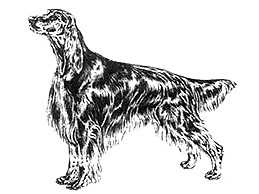Breed standards
Irish Setter
Breed standards are the official guidelines that describe the ideal characteristics, temperament, and appearance of a breed and ensures that the breed is fit for function with soundness essential.

Kennel Club, London 1994
Must be racy, balanced and full of quality. In conformation, proportionate.
Most handsome and refined in looks, tremendously active with untiring readiness to range and hunt under any conditions.
Demonstrably affectionate.
Head long and lean, not narrow or snipy, not coarse at the ears. Skull oval (from ear to ear) having plenty of brain room and well-defined occipital protuberance. From occiput to stop and from stop to tip of nose to be parallel and of equal length, brows raised showing stop. Muzzle moderately deep, fairly square at end. Jaws of nearly equal length, flews not pendulous, nostrils wide. Colour of nose dark mahogany, dark walnut or black.
Dark hazel to dark brown, not too large, preferably like an unshelled almond in shape, set level (not obliquely), under brows showing kind, intelligent expression.
Of moderate size, fine in texture, set on low, well back and hanging in a neat fold close to head.
Jaws strong with a perfect, regular and complete scissor bite, i.e. Upper teeth closely overlapping the lower teeth and set square to the jaws.
Moderately long, very muscular but not too thick, slightly arched and free from all tendency to throatiness, setting cleanly without a break of topline into shoulders.
Shoulders fine at points, deep and sloping well back. Forelegs straight and sinewy having plenty of bone, with elbows free, well let down and not inclined either in nor out.
Chest as deep as possible, rather narrow in front. Ribs well sprung leaving plenty of lung room and carried well back to muscular loin, slightly arched. Firm straight topline gently sloping downwards from withers.
Wide and powerful. Hindlegs from hip to hock long and muscular, from hock to heel short and strong. Stifle and hock joints well bent and not inclined either in nor out.
Small, very firm; toes strong, close together and arched.
Of moderate length proportionate to size of body, set on just below the level of the back, strong at root tapering to a fine point and carried as nearly as possible on a level with or below the back.
Free flowing, driving movement with true action when viewed from front or rear, and in profile, showing perfect co-ordination.
On head, front of legs and tips of ears, short and fine, on all other parts of body and legs of moderate length, flat and as free as possible from curl or wave. Feathers on upper portion of ears long and silky; on back of fore and hindlegs long and fine. Fair amount of hair on belly, forming a nice fringe which may extend on chest and throat. Feet well feathered between toes. Tail to have fringe of moderately long hair decreasing in length as it approaches point. All feathering to be as straight and flat as possible.
Rich chestnut with no trace of black. White on chest, throat, chin or toes, or small star on forehead or narrow streak or blaze on nose or face not to disqualify.
Not Specified.
Any departure from the foregoing points should be considered a fault and the seriousness with which the fault should be regarded should be in exact proportion to its degree and its effect upon the health and welfare of the dog, and on the dog’s ability to perform its traditional work.
Male animals should have two apparently normal testicles fully descended into the scrotum.

